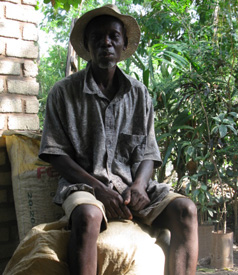This is Elsie’s 100th year: Continue reading
Category Archives: History
Haitian: Monsanto seeds are a new earthquake
 Beverly Bell writes in truthout that
Haitian Farmers Commit to Burning Monsanto Hybrid Seeds:
Beverly Bell writes in truthout that
Haitian Farmers Commit to Burning Monsanto Hybrid Seeds:
In an open letter sent May 14, Chavannes Jean-Baptiste, the executive director of MPP and the spokesperson for the National Peasant Movement of the Congress of Papay (MPNKP), called the entry of Monsanto seeds into Haiti “a very strong attack on small agriculture, on farmers, on biodiversity, on Creole seeds … and on what is left our environment in Haiti.”Fortunately, the Haitian government agrees:
For now, without a law regulating the use of GMOs in Haiti, the Ministry of Agriculture rejected Monsanto’s offer of Roundup Ready GMOs seeds. In an email exchange, a Monsanto representative assured the Ministry of Agriculture that the seeds being donated are not GMOs.Well, who could doubt Monsanto? Apparently some influential Haitians. They even get that it’s not just about the chemicals:
Haitian social movements’ concern is not just about the dangers of the chemicals and the possibility of future GMOs imports. They claim that the future of Haiti depends on local production with local food for local consumption, in what is called food sovereignty. Monsanto’s arrival in Haiti, they say, is a further threat to this.Maybe people in other countries will also act to preserve what is left of our environment.
Solving the 10,000 Year Old Problem of Agriculture
 Richard Harris reports on NPR, 21 Oct 2009, about
Prairie Pioneer Seeks To Reinvent The Way We Farm.
Wes Jackson wants to solve
the 10,000 year old problem of agriculture:
Richard Harris reports on NPR, 21 Oct 2009, about
Prairie Pioneer Seeks To Reinvent The Way We Farm.
Wes Jackson wants to solve
the 10,000 year old problem of agriculture:
The problem, Jackson explains, is that agriculture in most places is based on practices that use up limited resources. The major grains, like wheat and corn, are planted afresh each year. When the fields are later plowed, they lose soil. The soil that remains in these fields loses nitrogen and carbon.The solution will have to be somewhat different for each region, Continue readingThis worries Jackson because vast quantities of soil are washed out of the fields and down the rivers, and the soil that’s left is gradually losing its nutrients.
Trying to figure out how to solve this problem, Jackson realized the answer was right in front of him. It was the patch of native prairie on his own farm — full of grasses from ankle to shoulder height, peppered with white and purple flowers, and surrounded by shrubs and cottonwood trees.
“Here is a steep, sloping bank with a lot of species diversity, featuring perennials,” Jackson says. “This is what I call nature’s wisdom.”
Perennials are plants that put down strong roots 10 feet or more into the ground and hold the soil in place. Perennials live year-round, unlike annual crops that get planted every year. In Kansas, perennials survive the harsh winters and the blazing hot summers.
Enlisting the Health Industry Against Big Food
The moment these new rules take effect, health insurance companies will promptly discover they have a powerful interest in reducing rates of obesity and chronic diseases linked to diet. A patient with Type 2 diabetes incurs additional health care costs of more than $6,600 a year; over a lifetime, that can come to more than $400,000. Insurers will quickly figure out that every case of Type 2 diabetes they can prevent adds $400,000 to their bottom line. Suddenly, every can of soda or Happy Meal or chicken nugget on a school lunch menu will look like a threat to future profits.High fructose corn syrup treated like nicotine: it could happen.When health insurers can no longer evade much of the cost of treating the collateral damage of the American diet, the movement to reform the food system — everything from farm policy to food marketing and school lunches — will acquire a powerful and wealthy ally, something it hasn’t really ever had before.
AGRIBUSINESS dominates the agriculture committees of Congress, and has swatted away most efforts at reform. But what happens when the health insurance industry realizes that our system of farm subsidies makes junk food cheap, and fresh produce dear, and thus contributes to obesity and Type 2 diabetes? It will promptly get involved in the fight over the farm bill — which is to say, the industry will begin buying seats on those agriculture committees and demanding that the next bill be written with the interests of the public health more firmly in mind.
In the same way much of the health insurance industry threw its weight behind the campaign against smoking, we can expect it to support, and perhaps even help pay for, public education efforts like New York City’s bold new ad campaign against drinking soda.
Happy Fourth
 In memory of that old privateer, Commodore Essex Hopkins (1718 – 1802),
first ranking officer of the U.S. Navy, and my great-great-great-great-great-grandfather, here’s a picture of the Commodore’s flag: DONT TREAD ON ME.
In memory of that old privateer, Commodore Essex Hopkins (1718 – 1802),
first ranking officer of the U.S. Navy, and my great-great-great-great-great-grandfather, here’s a picture of the Commodore’s flag: DONT TREAD ON ME.
South Georgia Foodways, Agrirama, Tifton, June 26th, 2009
 Agrirama had a vine cutting Saturday for a Smithsonian food exhibit that will be there a while, with numerous accompanying events.
Tuesday evening there’s Organic Gardening Basics, and Friday there’s a South Georgia Foodways Festival, among quite a few others.
Agrirama had a vine cutting Saturday for a Smithsonian food exhibit that will be there a while, with numerous accompanying events.
Tuesday evening there’s Organic Gardening Basics, and Friday there’s a South Georgia Foodways Festival, among quite a few others.
Old Dorchester, S.C.
The canopy road leading to the entrance of Old Dorchester State Park, South Carolina:
